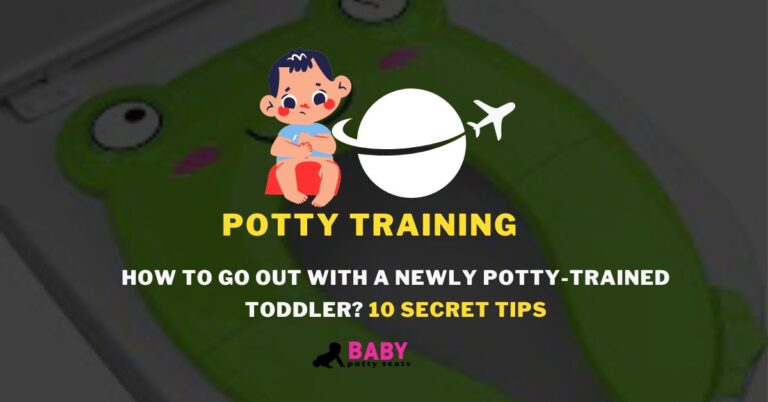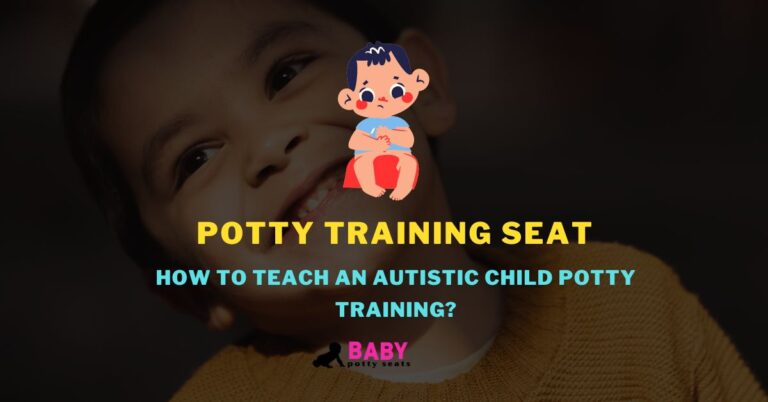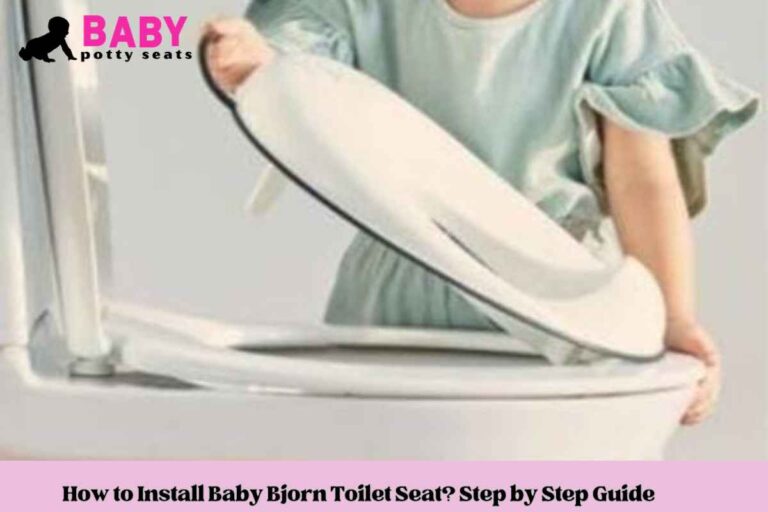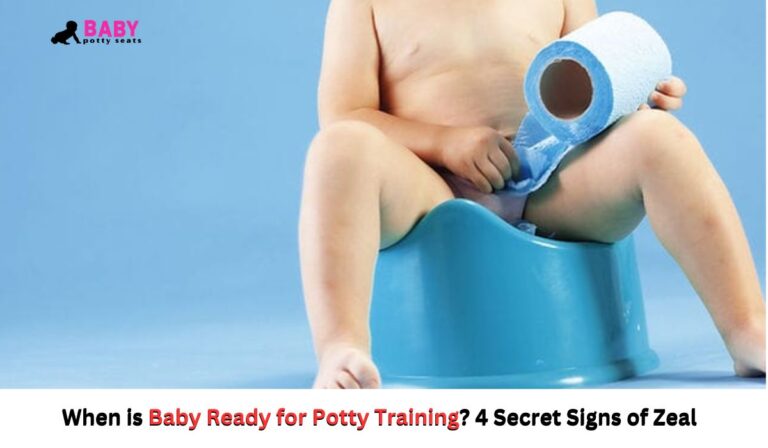Your baby should be introduced to potty seats gradually and positively. But first, you need to know how to use the potty seat for a baby.
Start by setting up the potty seat in a prominent, easily accessible area, and let your child explore and grow accustomed to it.
Pick a suitable time to start potty training, such as right after a meal or right before your baby is expected to have a bowel movement.
Put on clothing that will make it easier for you to remove for your infant. When your baby uses the potty seat successfully, give them encouragement and praise. If they have an accident, don’t scold them. Positive reinforcement is essential. Since each baby learns at their own pace, patience is essential.
How do you use a baby potty seat for toddlers?
Ensure your toddler is comfortable and age-appropriate for the potty seat before switching from a baby to a toddler. Establish a consistent potty training schedule to establish familiarity and routine.
Allowing toddlers to flush the toilet and wash their hands will promote independence and make the process more enjoyable. Provide toys or educational materials to keep toddlers busy. At the same time, they use the potty seat, making it a fun and productive activity.
Start weaning your toddler from diapers to underwear gradually as they get more comfortable. This will help them feel independent and accomplished.
How do I get my baby to use a potty seat?
Your baby can use a potty seat in multiple steps. To establish familiarity, start the potty seat introduction process by letting your baby see and touch it.
To create a routine, choose a time for potty training that is reliable, like right after dinner. Providing your baby with positive reinforcement, like encouragement and praise, is essential to getting them to use the potty seat properly.
Put on simple clothes to take off for your infant to facilitate a more convenient experience.
Keeping a positive association with the potty seat requires patience and not berating when accidents happen.
How to use a baby potty seat video
Use relevant keywords like “how to use baby potty seat” to search YouTube and other online platforms for instructional videos on how to use a potty seat for babies. Seek videos showing you how to use the potty seat step-by-step, give helpful advice, and present an illustrated manual. These videos can be useful visual aids that provide parents with extra information and direction. At the same time, they navigate the potty training process.
How to fix a baby’s potty seat?
Let’s go into more detail about how to fix a baby potty seat, with a focus on seat reducers and built-in potty training toilet seats:
1. Instability Issues:
– Tightening Screws and Bolts: Make sure all of the bolts and screws holding the potty seat in place are tight. Your baby could be in danger of instability due to loose connections. You can use a wrench or a screwdriver to make sure it fits snugly.
– Inspection for Damage: Examine the toilet seat for any obvious fractures, cracks, or other damage indicators. If the seat has structural problems that compromise its stability, it is advisable to replace it to ensure user safety.
2. Cleanliness Concerns:
– Routine Cleaning: Make cleaning the potty seat a regular ritual to avoid the growth of bacteria or offensive odors. Apply a gentle disinfectant or a cleaning solution safe for small children, and focus on any areas that may be more difficult to reach.
– Removable Components: Use the removable feature if you want to thoroughly clean the potty seat. To keep your baby’s environment hygienic, remove the seat from time to time to clean it and the toilet bowl.
3. Comfort Enhancement:
– Adding Cushioning: The firm surface of a potty seat may cause discomfort for certain infants. To improve your child’s experience, consider including a cushion or a seat reducer with more padding. Make sure that any additional accessories are fastened firmly.
4. Addressing Fit Issues:
– Proper Adjustment: Ensure seat reducers are adjusted correctly to fit snugly on the standard toilet seat. Your baby may become uncomfortable and reluctant to use the potty due to misalignment or movement.
– Use of Supportive Steps: If your infant finds reaching the integrated potty seat challenging, particularly on adult-sized toilets, a step stool can offer essential assistance. Thanks to this, your child can now use the potty.
5. Evaluate for Wear and Tear:
– Hinge Inspection: Look for evidence of wear and tear on the built-in potty seat’s hinges. It might be time to replace the seat or the hinge mechanism if the hinges are broken, not working properly, or wobbling excessively.
6. Reassess Training Approach:
– Observation and Adaptation: Observe your baby’s reactions during potty training. If discomfort or resistance continues, think about changing the way you train. This could be changing the frequency of potty sessions, adding more positive reinforcement, or making the process more entertaining for your child.
7. Seek Professional Help:
– Manufacturer Guidelines: Consult the manufacturer’s instructions for guidance on troubleshooting. If the potty seat is still covered by warranty, it could be helpful to adhere to the advice provided by the manufacturer or get help from their customer service.
– Professional Inspection: If issues continue and you cannot fix them, consider hiring a qualified field technician or plumber. They can comprehensively examine the integrated toilet seat to guarantee that every part operates well.
By addressing these issues, you can improve the built-in potty seat’s comfort, safety, and functionality, making potty training more enjoyable for both you and your child.
How to clean baby potty seats?
Cleaning a baby’s potty seat is essential for preserving cleanliness and giving your child a healthy environment. Here’s a step-by-step guide on how to clean a baby potty seat:
1. Gather Cleaning Supplies:
– Gather the cleaning supplies needed, such as disinfectant wipes, a soft cloth or sponge, mild soap or a baby-safe cleaning solution, and a scrub brush if needed.
2. Remove Seat or Components (if applicable):
– Remove any detachable or removable parts from the potty seat for a deeper cleaning. This could apply to the splash guard, seat, or detachable component.
3. Empty Waste Container (if applicable):
– Empty the waste container with the potty seat into the toilet and clean it separately. Use water and a mild soap solution to rinse it.
4. Wipe Down the Surface:
– Wipe the potty seat’s surface with a soft cloth or sponge. Areas that come into direct contact with your baby’s skin require special attention.
5. Scrub Stubborn Stains (if necessary):
– To remove difficult stains, gently scrub the affected areas with a scrub brush or an old toothbrush and mild soap. Steer clear of abrasive materials that might harm the surface.
6. Clean Hinges and Crevices:
– Particular attention should be paid to hinges and any cracks where dirt or debris could collect. To ensure a complete cleaning, reach into these areas with a scrub brush or a cotton swab.
7. Disinfect the Potty Seat:
– To eradicate all bacteria and germs, disinfect the toilet seat. Disinfectant wipes or a solution made of water and a baby-safe disinfectant can be used. If you use any specific cleaning products, follow the manufacturer’s instructions.
8. Rinse with Water:
– To remove any last bits of soap or cleaning solution, give the potty seat a thorough water rinse after cleaning and disinfecting. It’s crucial to take this action to shield your baby’s skin from irritation.
9. Air Dry or Pat Dry:
– Let the toilet seat air dry entirely. Use a paper towel or a fresh, dry cloth to pat it dry quickly. Steer clear of towels and other materials that could scratch the potty seat or add fibers.
10. Reassemble (if applicable):
– Before reassembling the potty seat, ensure that any removed components are completely dry. Comply with the manufacturer’s guidelines to ensure correct reassembly.
11. Maintain a Regular Cleaning Routine:
– Make sure to clean the potty seat regularly to avoid the accumulation of bacteria. If your baby uses it frequently, try cleaning it more often than once a day.
It’s important to always refer to the manufacturer’s instructions for precise cleaning directions because certain potty seats might have special materials or unique features that call for extra attention. Frequent cleaning extends the life of the potty seat and guarantees a clean environment for your infant.
When should the baby sit on the potty?
The timing for when a baby should start sitting on a potty varies for each child, as development occurs at an individual pace. When a baby might be prepared for potty training, though, can be determined by looking for certain universal readiness indicators. The following are some typical indicators that your child should begin using a potty:
1. Physical Readiness:
– Sitting Independently: Your infant should be able to sit up independently and keep their balance. This usually occurs after six to eight months.
2. Communication Skills:
– Expressing Discomfort with Diapers: Your baby may be alert and ready if they exhibit discomfort or annoyance when wearing wet or dirty diapers.
3. Motor Skills:
– Pulling at Diapers: Urinary curiosity may manifest in your baby if they tug at their diaper or show interest in the diaper-changing procedure.
4. Recognizing Bodily Functions:
– Verbal or Non-verbal Cues: Certain sounds, motions, or facial expressions may be displayed by some babies in anticipation of a bowel movement or urine leak.
5. Consistency in Bowel Movements:
– Predictable Patterns: It could be a good idea to introduce the potty at this time if your baby has regular bowel movements and you can predict when they might occur.
6. Interest in the Toilet:
– Curiosity about the Bathroom: Your baby may be ready for potty training if they exhibit interest in using the restroom or mimic family members during bathroom routines.
7. Ability to Follow Simple Instructions:
– Understanding Basic Commands: Your baby might be more open to using the potty if they are beginning to comprehend and comply with basic instructions.
8. Ability to Communicate:
– Verbal or Non-verbal Communication: Your baby should be able to express their needs, including using the potty, through words, gestures, or signals.
Remember that every child is different and that these signs are only suggestions. Some people might be more prepared than others. It’s critical to exercise patience, pay attention to your baby’s cues, and introduce the potty encouragingly and helpfully.
While it’s generally advised to start potty training a child between 18 and 24 months, some may only be completely trained once they are closer to 2 or 3 years old. Always pay attention to the cues your child gives you, and modify your strategy according to their comfort and level of readiness.
Conclusion
This article discusses how to use baby potty seats for toddlers. You can use them easily by locating the place, fixing it correctly, and then using them for potty training. Use a mild soap with towels, wipes, or tissue paper to make them disinfect and clean them. I hope you find this guide useful. If you have more questions, let me know.
Related Blog Post: Top 10 Best Toilet Training Seat With Ladder-2024









One Comment
Comments are closed.